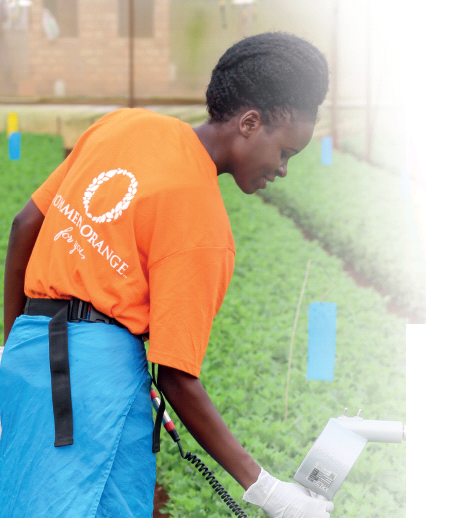
‘Minimal chemicals, maximum quality' is what it says on the cover of the GreenGuard ornamentals brochure. This sentence is as clear-cut as it gets. Dümmen Orange works together with Koppert to make the ornamentals chain even more sustainable. The ambitions that these two giants share is immense.
The developments that first happened in the vegetable horticulture sector are now also clearly taking place in the ornamentals sector, with an increasing number of market players demanding that their suppliers use as few chemicals as possible on the flowers and plants that they deliver. This shift inspired Dümmen Orange to set a brand-new course just a few years ago.
Modernizing cultivation and markets
Dümmen Orange has a total of 20 branches, 7,700 employees, and a turnover of 355 million euros, making them a giant in the global ornamentals sector.
Driven by their ambition to be a leader in the modernization of cultivation and markets, the company made sustainability a key focus area in its business operations a few years ago. Koppert was contacted to help them achieve this.
The two companies first looked at how Koppert could help to make the production of propagation material by Dümmen Orange significantly more sustainable, starting with the production of chrysanthemum cuttings in Uganda. Was it possible to achieve a production of cuttings using a minimum of chemical products in which the use of biological crop protection could be maximized?
The immediate application of beneficials
‘GreenGuard was the result of our collaboration,’ explains biologist Manuela van Leeuwen from Dümmen Orange. Her first job was at chrysanthemum breeder Fides, but she now coordinates sustainable production projects for flowers and plants at Dümmen Orange.
‘We developed the GreenGuard protocol together with Koppert. It involves a method in which we use as few chemicals as possible on our chrysanthemum farm in Uganda, ensuring that the chemicals that do need to be used are not harmful to the beneficials. The most sensitive beneficials can get started quite easily as a result, and the grower can immediately release the beneficials after receiving his GreenGuard cuttings.’
This improves crop security and significantly enhances the success rate of biological crop protection. ‘GreenGuard strengthens the position of the grower in the market,’ states Van Leeuwen. ‘And all the links in the chain that follow this, right up to consumers across the world, profit too.’
More authorizations, more possibilities
The GreenGuard protocol for potted chrysanthemums involves the use of the predatory mites Amblyseius swirskii (Swirski-Mite) and Neoseiulus californicus (Spical), of the insect-parasitizing nematode Steinernema feltiae (Entonem), and of Horiver sticky traps. ‘These are the products that are currently authorized in Uganda,’ explains Koppert consultant Ellen Klein.
But a great deal of work was needed to get these authorizations passed. ‘This was due to the unfamiliarity of the Ugandan government with beneficials and the way in which they work. But we have managed to overcome this hurdle and are now working very effectively with the authorities. We are currently getting everything in order to apply for authorization for other products. If we can use more beneficials in Uganda, we have more options to further reduce the use of chemicals.’
Towards application in more crops
Koppert and Dümmen Orange are now working on the application of GreenGuard to more crops such as pelargoniums, roses, anthuriums, poinsettia, and a number of standard plants. ‘It is our goal to eventually apply GreenGuard to all our products,’ says Manuela van Leeuwen. ‘The success of its application to chrysanthemums has served as a source of inspiration for Dümmen Orange.’ ‘And for Koppert too!’ adds Ellen Klein.